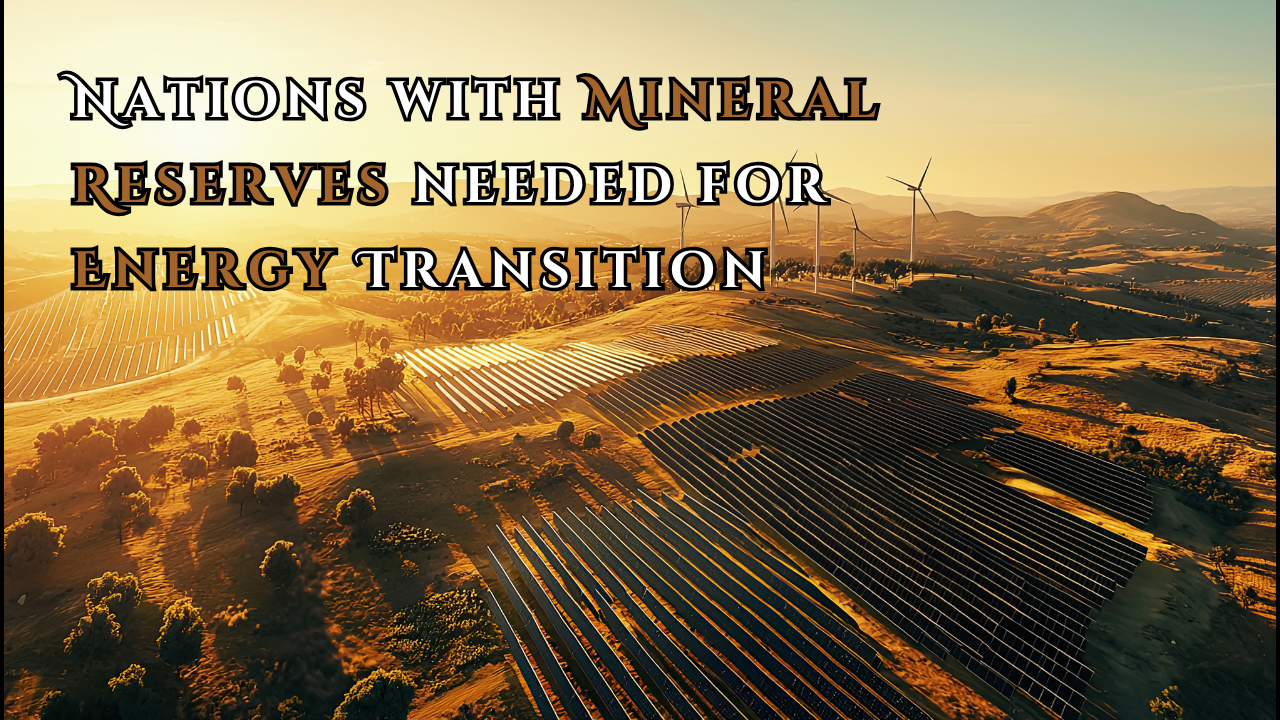Nations with Mineral Reserves needed for Energy Transition
Context:
The global renewable energy system is currently dominated by fossil fuels, but the transition to a low-carbon economy will require a shift towards minerals essential for renewable technologies like solar, wind, nuclear power, and more.

Breakdown
- Bauxite: The primary source of aluminium, crucial for wind turbines, solar panels, batteries, electrolyzers, and transmission cables.
- Chromium: Essential for geothermal energy and concentrated solar power. It’s also used in wind turbines and for radiation shielding in nuclear plants.
- Cobalt: Vital for consumer electronics, metal alloys, and oil industry catalysts. It plays a critical role in many lithium-ion battery technologies.
- Copper: A critical component in solar panels, wind turbines, battery storage systems, and electricity grids.
- Graphite: A key element in battery anodes, making it important for electric vehicles and stationary batteries used to balance electricity grids.
- Lithium: A core material in lithium-ion batteries.
- Manganese: Widely used in solar and wind power technologies, as well as in lithium-ion batteries for electric vehicles.
- Molybdenum: Known for its high electrical conductivity and minimal expansion when exposed to heat.
- Nickel: A crucial component in the cathodes of lithium-ion batteries used in electric vehicles.
- Rare Earth Elements: Important for wind power, particularly in the production of permanent magnets.
- Silver: Plays a key role in solar photovoltaics and electric vehicles.
- Uranium: The primary fuel for nuclear energy production.
Each of these minerals is critical to the development of renewable energy technologies and will shape the future of the global energy supply. The availability of these mineral reserves across countries will influence the pace and structure of the energy transition.
Steps taken by IndiaIndia is actively pursuing an energy transition aimed at reducing reliance on fossil fuels and increasing the share of renewable energy in its energy mix. Renewable Energy Targets: India has set a target of achieving 500 GW of renewable energy capacity by 2030, which includes solar, wind, and other renewable sources. Increased Subsidies for Renewables: In FY 2023, subsidies for renewable energy increased to INR 14,843 crore (approximately USD 1.8 billion), reflecting a commitment to support clean energy initiatives. Production-Linked Incentive (PLI) Schemes: The government introduced PLI schemes to boost domestic manufacturing of solar panels and other renewable technologies. Wind-Solar Hybrid Policy: Launched in 2018, this policy promotes the integration of wind and solar power generation to optimise resource use and improve grid stability. Green Hydrogen Mission: India aims to produce 5 million tonnes of green hydrogen by 2030, supported by a significant increase in renewable energy capacity. Ultra Mega Renewable Energy Parks: The government is establishing large-scale renewable energy parks that provide necessary infrastructure, including land and transmission facilities, for developers. Green Energy Corridors: New transmission lines and substations are being developed to facilitate the evacuation of renewable power from generation sites to consumption areas. Waiver of Transmission Charges: The government has waived inter-state transmission system charges for solar and wind power projects commissioned by June 2025, promoting greater investment in these sectors. Customs Duty Exemptions: Exemptions on customs duties for critical minerals and machinery required for renewable energy projects have been introduced to lower costs and encourage investment. Global Leadership in Renewable Energy: India has taken a leadership role in international forums, such as the G20, advocating for a tripling of global renewable energy capacity by 2030. |
|
subscribe to our Youtube Channel for more Valuable Content – TheStudyias
Download the App to Subscribe to our Courses – Thestudyias
The Source’s Authority and Ownership of the Article is Claimed By THE STUDY IAS BY MANIKANT SINGH






